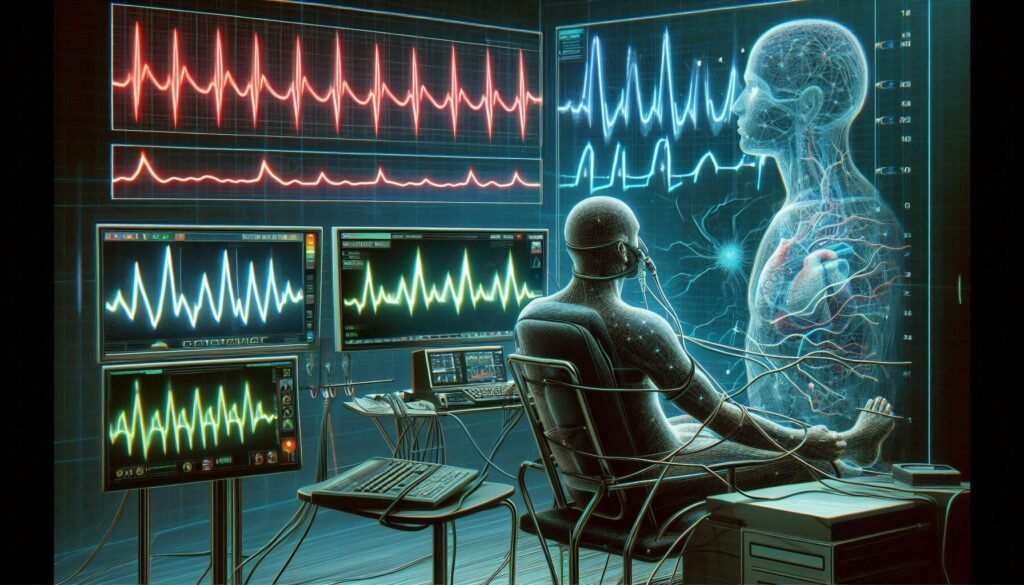Catatonia is a complex neuropsychiatric syndrome that can manifest in various ways, often leaving both patients and caregivers bewildered. One of the most intriguing aspects of catatonia is its impact on the autonomic nervous system (ANS). This intricate network controls involuntary bodily functions such as heart rate, blood pressure, and even digestion. When someone enters a catatonic state, their ANS may react unpredictably, leading to significant physiological changes.
Understanding these autonomic abnormalities in catatonia not only sheds light on this enigmatic condition but also highlights the importance of monitoring vital signs for effective management and treatment. In this article, we will explore how catatonia affects vital signs and what that means for those experiencing it or caring for them. Join us as we delve into the fascinating world of autonomic dysfunction in catatonic states!

The Autonomic Nervous System in Catatonia: An Overview
The autonomic nervous system (ANS) is crucial for maintaining homeostasis within the body. It operates automatically, controlling functions such as heart rate, respiratory rate, and digestion without conscious effort. In catatonic states, this system can become dysregulated, leading to a range of abnormalities.
Catatonia often presents with various motor symptoms and altered mental status. However, underlying these manifestations are significant changes in the ANS’s functioning. This disruption can result in physiological responses that complicate diagnosis and treatment.
Research indicates that both sympathetic and parasympathetic branches of the ANS may be affected during catatonic episodes. For instance, heightened sympathetic activity could lead to increased heart rates or elevated blood pressure levels. Conversely, an overactive parasympathetic response might cause dizziness or fainting.
Understanding these effects is essential for healthcare providers managing patients with catatonia. By recognizing how the ANS behaves in this context, they can better tailor interventions aimed at stabilizing vital signs and improving patient outcomes.
Common Autonomic Abnormalities in Catatonic States
Catatonia is often accompanied by various autonomic abnormalities that can significantly impact a patient’s health. These changes reflect the dysregulation of the autonomic nervous system, which controls involuntary bodily functions. Patients may experience fluctuations in heart rate and blood pressure, leading to potential cardiovascular complications.
Another common issue involves temperature regulation. Individuals in catatonic states may exhibit hyperthermia or hypothermia due to impaired thermoregulation. This fluctuation can pose serious risks if not monitored closely.
Sweating abnormalities frequently arise as well. Some patients may sweat excessively while others become noticeably dry-skinned, reflecting disrupted sympathetic nervous system activity. Such variations can complicate both diagnosis and treatment strategies.
Gastrointestinal issues also manifest during catatonic episodes. Constipation, bowel obstruction, or urinary retention can occur due to altered autonomic control over these systems, further exacerbating the patient’s overall condition and comfort level.
Heart Rate and Blood Pressure Changes in Catatonia
Catatonia is often accompanied by significant changes in heart rate and blood pressure. These alterations can manifest as tachycardia, where the heart beats faster than normal, or bradycardia, which indicates a slower heartbeat. Both conditions can pose risks to patients if not monitored closely.
Moreover, fluctuations in blood pressure are common during catatonic episodes. Some individuals may experience hypotension, leading to feelings of dizziness or faintness. Others might have hypertension that raises concerns about cardiovascular health.
The autonomic nervous system plays a crucial role in regulating these vital signs. In catatonia, its dysfunction leads to unpredictable shifts that necessitate vigilant observation from healthcare providers.
Understanding these changes is critical for effective management of catatonia. By assessing heart rate and blood pressure regularly, medical teams can better protect patient well-being and tailor interventions accordingly.
Temperature Regulation Issues in Catatonic Patients
Temperature regulation is a critical function of the autonomic nervous system, and its disruption can significantly affect catatonic patients. These individuals often experience dysregulation, leading to either hyperthermia or hypothermia. Such fluctuations can pose serious health risks.
Hyperthermia may occur due to inadequate thermoregulation during prolonged immobility. In some cases, excessive heat production from muscle rigidity exacerbates this condition. Conversely, hypothermia can arise if patients remain in cool environments for extended periods without movement.
Patients may also exhibit an inability to respond adequately to temperature changes in their surroundings. This lack of responsiveness complicates the management of their overall care because they might not show typical signs of discomfort or distress associated with extreme temperatures.
Moreover, ineffective temperature regulation is linked to further complications such as infections and metabolic imbalances. Therefore, close monitoring becomes essential for ensuring patient safety and well-being during treatment interventions.
Sweating Abnormalities and Skin Changes in Catatonia
Sweating abnormalities are a significant concern in catatonic states. Patients may experience hyperhidrosis, characterized by excessive sweating, or hypohidrosis, where sweat production is drastically reduced. These changes can pose risks to the individual’s health and comfort.
Skin changes often accompany these sweating issues. Patients may develop rashes or skin irritation due to prolonged immobility and poor hygiene. The inability to move can lead to pressure sores and other dermatological complications if not carefully monitored.
The relationship between autonomic nervous system dysfunction and skin alterations underscores the importance of vigilant care for catatonic patients. Regular assessments help identify any emerging issues promptly, which can significantly improve patient outcomes.
Moreover, addressing these abnormalities requires an interdisciplinary approach involving psychiatrists, neurologists, and nursing staff. This teamwork ensures that both mental health needs and physiological symptoms receive adequate attention throughout treatment.
Gastrointestinal and Urinary Dysfunction in Catatonic States
Catatonia is often accompanied by significant gastrointestinal and urinary dysfunction. Patients may experience a range of issues, from constipation to more severe bowel obstructions. These problems arise due to decreased motility in the digestive system, which can result from disrupted autonomic control.
Additionally, urinary difficulties are common among individuals in catatonic states. Some patients may have difficulty urinating or exhibit urinary retention. This can lead to discomfort and further complications if not addressed promptly.
The lack of movement during catatonia also contributes to these dysfunctions. Prolonged immobility affects normal bodily functions, exacerbating gastrointestinal issues and impacting bladder health.
Monitoring these symptoms is essential for effective management of catatonic patients. Ensuring proper hydration and nutrition while addressing any signs of distress will contribute significantly to overall care strategies. Prompt interventions can help mitigate complications arising from these autonomic abnormalities.
Respiratory Changes and Risks in Severe Catatonia
Severe catatonia can significantly impact respiratory function. Patients may exhibit shallow breathing, reduced tidal volume, or even periods of apnea. These changes can stem from muscular rigidity and the inability to initiate normal respiratory patterns.
The risk of hypoxia increases in such cases, as oxygen intake is compromised. Additionally, patients might develop atelectasis—collapse of lung tissue—due to prolonged immobility and inadequate lung expansion. This condition can exacerbate existing pulmonary problems.
Monitoring respiratory rates is crucial for early detection of these issues. Medical professionals often use pulse oximetry to assess blood oxygen levels continuously. Quick interventions are essential when abnormalities arise.
Furthermore, aspiration pneumonia poses a significant risk due to impaired swallowing reflexes in some catatonic patients. Maintaining airway patency becomes vital during treatment to prevent further complications related to respiratory distress.
Monitoring Vital Signs: Importance in Catatonia Management
Monitoring vital signs in patients with catatonia is crucial for several reasons. This condition often presents with autonomic abnormalities that can significantly impact overall health. Regularly checking heart rate, blood pressure, and temperature provides essential insights into the patient’s physiological state.
Changes in these vital signs may indicate emerging complications or worsening of the catatonic state. For example, significant fluctuations in heart rate can signal distress or potential cardiovascular issues. Timely detection allows for prompt intervention and helps to stabilize the patient’s condition.
Moreover, monitoring respiratory function is vital as it directly affects oxygenation and carbon dioxide removal from the body. Respiratory distress can arise unexpectedly in severe cases of catatonia, necessitating immediate medical attention.
Consistent observation aids healthcare providers in tailoring treatment plans more effectively. Understanding how a patient responds to interventions through their vital sign changes enhances care strategies and supports better recovery outcomes.
Treatment Approaches for Autonomic Abnormalities in Catatonia
Treatment approaches for autonomic abnormalities in catatonia require a comprehensive strategy tailored to the individual’s needs. Psychotropic medications, particularly benzodiazepines and certain antipsychotics, can help stabilize mood and reduce severe symptoms. These drugs often target underlying psychiatric conditions that contribute to catatonic states.
In addition to pharmacological interventions, supportive care is crucial. Monitoring vital signs consistently allows healthcare providers to identify any emerging complications early on. This vigilance helps ensure timely responses when changes occur in heart rate or blood pressure.
Non-pharmacological treatments play an essential role as well. Therapeutic techniques such as cognitive-behavioral therapy (CBT) can assist individuals in coping with their symptoms more effectively. Incorporating physical therapies may also promote better overall health and improve autonomic function over time.
Addressing lifestyle factors is vital for long-term management of autonomic abnormalities in catatonia. Encouraging regular exercise, proper nutrition, and adequate hydration supports the body’s natural functions while enhancing recovery prospects.
Long-Term Health Implications of Autonomic Dysfunction in Catatonia
Long-term autonomic dysfunction in catatonia can lead to significant health complications. Patients may experience chronic cardiovascular issues due to persistent heart rate and blood pressure irregularities. Prolonged abnormal temperature regulation can also result in heat-related illnesses or hypothermia, impacting overall well-being.
Additionally, gastrointestinal problems are common among those with ongoing autonomic abnormalities. This can manifest as chronic constipation or diarrhea, which not only affects comfort but also nutrition and hydration status. Urinary dysfunction may contribute to further complications such as urinary tract infections.
Respiratory changes pose a major risk too. Frequent breathing irregularities could potentially lead to respiratory failure if left unmonitored and untreated over time. Regular assessment of vital signs is crucial for managing these risks effectively.
Without appropriate intervention, the long-term impact on mental health can be substantial as well. The stress of living with these physical symptoms often exacerbates mood disorders like anxiety or depression, creating a cycle that’s hard to break.
Addressing autonomic abnormalities early on through targeted treatment strategies is essential for improving quality of life in individuals suffering from catatonia while reducing future health risks associated with ongoing dysfunction.


